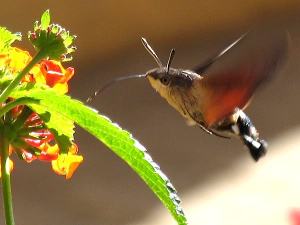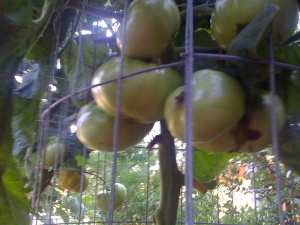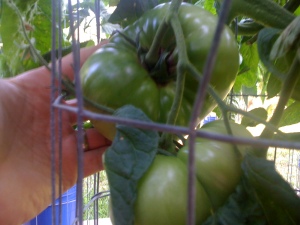Tobacco Horn worms have an insatiable appetite for my Greene tomatoes. The are lovely little caterpillars that come from the eggs planted by the Hummingbird Moth. I’ve been picking them off and killing them, but they are so camouflage they are almost impossible to spot. I plan on using a natural enzyme called Bacillus thuringiensis to control them naturally.
I’m also thinking about moving a few of them to sacrificial plants to see if I can hatch one of the beautiful Humming Bird Moths. Take a look at what these caterpillars mature to.
Here they are in a less beautiful and far more destructive form. The horn on its tail is soft and can not damage prey or people, it’s like an unloaded gun –useful only in scaring potential predators.
The plants are growing/producing well.
As of today I have picked 26 pounds of edible Brandywine tomatoes.
The largest I have picked so far was right under 2 pounds. It weighed 32 ounces to be exact:


















Posted by bob ans barbara on June 23, 2010 at 9:40 am
Parc, we can’t believe all of this is happening in a salty area. Congratulations on a fine job. I do love tomatoes ……..wish I were there to enjoy…..want to keep up with the changes.
Posted by Renee Deutsch-Kelder on September 27, 2010 at 7:28 am
Yesterday one of your fabulous moths turned up in my tiny front garden in the Hague, Holland. I was
glad that I had seen one on a nature program – no doubt by David Attenborough – or I would not have realized what it was. It was drinking from a perovskia. With regards, Renee.
Posted by Trev on July 6, 2010 at 9:44 pm
Parc,
Congrats on the ripening monsters. Sorry to hear about the lack of CPs. I hope you will have some ready to sell to the tourists by next week (we are coming down on Saturday).
Trev
Posted by Gene on July 13, 2010 at 1:00 pm
What a small world! I have been readin diff posts on Tomatoville and saw Parcgreene…who else could it be?!
Looks like you are doing a fine job down there. And most of that is done hydroponically?? Gloria and I also love Brandywines and plan on planting diff strains of it next year. Sorry about the CPs….they are prob our favorite but I never seem to get a large yield. We have several other varieties planted. She says I am obsessed with tomatoes but when I showed her your blog and those great pictures…..and in that diff enviorment….great job.
I will continue to follow your progrgess with your tomatoes….this is interesting!
Posted by parcgreene on May 19, 2011 at 11:56 pm
Thanks for the tomato plants you sent me. I placed them in soil 10 days ago, I’m going to allow two stems per plant and pinch the rest of the suckers. Can’t wait to try some new flavors I’ve never tasted. I’ll update the with pictures soon.
Posted by debra on August 4, 2011 at 2:14 pm
Wow, thanks! We were looking for info about humming moths (we have a bunch in our bee balm. We never realized the connection to the worms on our tomatoes!
Posted by John Alex on May 23, 2020 at 9:05 pm
How I hatched my own hummingbird moth. My son told me that the worm goes into the ground below the frost line for 30 days. I found a tiny tomato worm and put it in a gallon jar with tomato leaves.i fed it till it stopped growing. I filled a small fish tank with dirt and screen. When the worm looked sick and started going in circles I put in the tank. It drilled a hole to the bottom for 30 days. And voila, a beautiful hummingbird moth was on top of dirt flying around. Reluctantly I took it outside and let it go. Great experience. Now I kill no worms.😁
Posted by april on August 20, 2011 at 12:50 am
We found one in our garden and my son put it in a butterdish with dirt and tomatoe leaves inside and put the lid on after poking holes in the top and when all the leaves were gone, (in one night) it buried itself in the dirt and it made itself into a cacoon. A few weeks later the cacoon was on top of the dirt and we watched it emerge. I’m actually glad we had them in the garden because my son has never had success with any bug surviving captivity, and this was the best one yet!
Posted by Diego on May 5, 2012 at 9:27 pm
Hello, congratulations for ypur tomatoes. Now i know how the caterpillars of the hummingbird moth looks like, and what they eat. Something caught my attention, You said that Bacillus thuringiensis is an enzyme, but it is a microbe, a bacterium. So i think that this tiny organism makes an enzyme that kills the caterpillar. How this thing works? i mean, do you buy the enzyme as a liquid solution and spray it on your tomatoes plants? or you by a medium wich contains the bacteria and spray it? just wondering about it
🙂
Posted by Ana on May 14, 2012 at 11:26 pm
are those moths supposed to be in the US? I live in Wisconsin, and have seen them now twice, years apart, and in very seperate locations. I think they are beautiful. but I had never seen anything like it before.
Posted by Diana on May 21, 2012 at 10:42 pm
I live in Mt. Shasta, and I think I saw one today. I have many
tomato plants in my greenhouse. Please provide more info about the
enzymes you use. Thanks!
Posted by Megan Brayton on May 26, 2012 at 11:36 am
Hummingbird moths are NOT hornworm moths. They are two different species. Hornworm moth larvae found on tobacco is not the hummingbird moth. Hummingbird moths do not live on tobacco plants. They are found on honeysuckle and other similar sweet flowering plants, they do not feed on tobacco. hornworm moth larvae mature into a totally different species!!!!! They look somewhat similar, but are different from the traditional clearwing(aka hummingbird) moth.
Posted by mike on July 12, 2012 at 6:21 pm
Beautiful moth and beautiful tomatoes. Just to let you know, hornworms turn into sphinx (or hawk) moths, not hummingbird moths.
Posted by MaryAnne on July 12, 2012 at 10:58 pm
I tend to agree with you mike…see my comment and links.
Posted by Pamster on August 12, 2012 at 5:49 pm
We live in Dublin Ga. We “caught” a tobacca horn worm and feed her till she was over 3 inches. When we put soil in the small aquairum she immediatly went under the soil. I put plastic wrap over the top with air holes in it. We waited 21 days and …there she was! My kids LOVED this. We have had her as a moth for 2 days now. She hasnt tried to fly yet. She hasnt done anything. She will hold on to my fingers and crawl around or hold on to a plant. When does she fly? What can we feed her? We gave her hummingbird water and put her on a plant. Her wings look too small for her to fly.
Posted by granny d on August 27, 2012 at 5:41 pm
I live in North Dakota thought it was a hummingbird but as I got closer to it I realized it was a hummingbird moth I saw one last year but my friends thought i was seeing things but this time they were with me They are awesome to watch!
Posted by Paula on September 8, 2012 at 6:29 pm
I live in Idaho and have loads of hanging baskets which I have to water twice daily; but when I go out in the evening to water them, I have loads of the beautiful hummingbird moths dipping their long proboscuses (?) into the petunias, et al, to have a drink. I’d never seen them before, so had to do a web serch, hence found this page. I think they’re amazing! Does anybody know their life span?
Posted by bonnie on March 21, 2013 at 7:58 pm
I was talking to friends today about bees and told them about hummingbird bees i see each summer. We all live in Ontario Canada and apparently I am the only one that has ever seen them. They come to my flowers every year just one at a time so I never know if there are many or just one. Fascinating aren’t they.
Posted by Barb Blond on July 28, 2013 at 11:58 pm
Wow – you grow all these tomoatoes in baskets. One year I planted in baskets becauseI got a late start on the garden – they seemed ot need a lot of water that way. Saw my first hummingbird moth in the phlox today.
Posted by Barb Blond on July 29, 2013 at 12:03 am
Reread the post – I see you grow the tomatoes hydoponically. Thanks for a nice site.
Posted by Helen Young on July 29, 2013 at 4:45 pm
The tomato hornworm (which is eating the leaves if your plants) is NOT the same animal as the hummingbird moth! The tomato hornworm matures into a five-spotted hawkmoth. I suspect that the adult hawkmoth might not feed as an adult (but I might be wrong about that). But the pollinating hummingbird moth has larvae that feed on black cherry, honeysuckle, hawthorns, and viburnum – NOT tomatoes.
Posted by frejafolkvangar on March 17, 2015 at 12:53 am
I love hummingbird moths! We had one that hung out in our garden when I was growing up and then one showed up at our new house when we moved. I guess hummingbird moths and my mom have the same taste in flowers.
Posted by Gail on June 1, 2015 at 11:49 am
aww..crap ..they go after tomatoes… but regardless, I would sacrifice some tomato plants to watch the adults busy at work.. they are AWESOME..
I actually planted flowers to draw them..cause they are so awesome to watch…
they like tall phlox
but I like my tomato plants too… umm… a happy balance would be nice..but how does
one achieve that??
Posted by Sandra Hazen on April 6, 2016 at 8:46 am
FYI, the Hummingbird Moth does not produce the tobacco hornworm. It is the Carolina Sphinx Moth which produces the tobacco hornworm, a different species. The sphinx moth family is a large one, with many species. The Hummingbird Moth also does not produce the tomato hornworm. That is another species of sphinx moth which produces that pest.
Posted by Phillip Brandt on June 1, 2017 at 7:43 pm
I’ve grown a lot of tomatoes, didn’t know this caterpillar was that of the Hummingbird Moth (I love these creatures). I also encounter Tomatoe worms, considerably bigger, with “eyes’ on both ends, and horns….those critters are big, easily as big around as my index finger….they can eat up a harvest in no time flat.
Posted by BJ on August 21, 2019 at 12:33 pm
Hummingbird moth? or Sphinx moth? The adult of tomato worms is the later, I believe.
You have also labeled the photo of a hummingbird as a hummingbird moth. Oops.